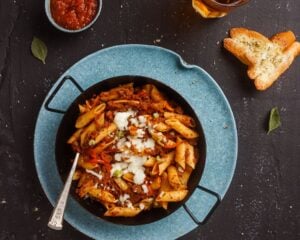Pasta enthusiasts frequently ponder whether to monitor calories before or after cooking, since dried noodles expand dramatically upon boiling. Five ounces of cooked dried spaghetti typically contains around 200 calories, offering energy from carbs with modest protein and fiber.
The manner in which it’s prepared al dente or soft does not alter calorie counts but affects the pace of digestion. Weighing dry portions or using measuring cups for cooked pasta assists in maintaining balanced meals without guesswork. Comprehending these specifics makes relishing pasta more straightforward for those conscious of nutrition.
Dry vs. Cooked Pasta Measurements
As measuring pasta, numerous individuals do not realize that dehydrated and prepared quantities are not the same. Dry pasta expands when cooked, nearly doubling in size, which means a cup of uncooked noodles won’t equal a cup after boiling.
Pasta volume measurements can be tricky—some rely on measuring cups, while others prefer pasta weight measurements for accuracy. A kitchen scale helps, since 2 ounces of dry spaghetti typically yields about 1 cup cooked. Without one, visual cues work: a fist-sized bundle of dry pasta often cooks to a single serving.
Mistakes happen when guessing, leading to overserving or underestimating portions. Comprehension of the difference ensures better meal planning, especially when nutrition matters. Cooks aiming for consistency should note that shapes like penne or fusilli absorb water differently than long strands. Maintaining awareness avoids surprises when plating dishes for others.
Calories in 5 Ounces of Cooked Dried Spaghetti
Five ounces of cooked dried spaghetti contains roughly 200 calories, though the exact number can vary slightly depending on the brand or cooking method. The pasta nutrient content remains relatively stable, providing carbohydrates for energy and small amounts of protein and fiber. Different pasta cooking methods, like boiling or steaming, don’t significantly alter the calorie count, but they can affect texture and absorption of sauces.
| Pasta Cooking Method | Effect on Calories |
|---|---|
| Boiled | Minimal change |
| Steamed | Slightly firmer |
| Al dente | Lower glycemic impact |
| Overcooked | Softer texture |
For those preparing meals for others, comprehension of these details secures balanced servings. The calorie count stays consistent, but pairing spaghetti with vegetables or lean proteins can create a more nutritious dish. Keeping portions measured helps maintain accuracy, especially when planning meals for specific dietary needs. The focus should remain on balance, guaranteeing both satisfaction and nourishment.
How Cooking Affects Pasta’s Caloric Density
- Water Absorption: Dry pasta absorbs water during cooking, increasing its volume but not its calories. This means a cooked portion looks larger but has the same energy as its dry counterpart.
- Cooking Time: Overcooking breaks down starches, making pasta easier to digest and potentially spiking blood sugar faster. Al dente pasta digests slower, helping maintain steady energy levels.
- Sauce Impact: While sauces don’t change pasta’s calories, heavier options like cream-based sauces add extra calories per serving.
Understanding these factors helps in preparing meals that are satisfying without unnecessary calorie spikes. Simple adjustments, like monitoring cooking time, can make a difference in how pasta fuels the body.
Portion Control Tips for Accurate Calorie Tracking
Measuring pasta portions can feel tricky, especially as cooked noodles seem to expand endlessly. To maintain healthy eating habits, weighing dry pasta before cooking guarantees accuracy, since 2 ounces of dry spaghetti roughly equals 5 ounces cooked. Using measuring cups for cooked pasta can help, but packing noodles too tightly skews portions.
A kitchen scale eliminates guesswork, offering precision for mindful portion sizes. Visual cues also help—a single serving of cooked pasta should fill about a fist-sized space on the plate. Pre-portioning meals ahead of time prevents overeating, while smaller plates create the illusion of a fuller serving.
Pairing pasta with vegetables or lean proteins balances the meal, making it more satisfying without excess calories. Practicing these strategies fosters consistency, helping those who serve others stay aligned with nutritional goals effortlessly.
Comparing Different Types of Pasta and Their Caloric Differences
Not all pasta is created equal as it pertains to calories, and the differences can surprise even seasoned cooks. Pasta varieties vary in carbohydrate content, texture, and density, which directly impacts their caloric value. For those mindful of nutrition, cognizance of these differences assists in making informed choices.
- Spaghetti (5 oz cooked): Around 220 calories, with 43g carbs. A classic choice, but heavier in carbs than some alternatives.
- Penne (5 oz cooked): Roughly 200 calories, 40g carbs. Slightly denser, so portions may feel more fulfilling.
- Whole Wheat Pasta (5 oz cooked): Approximately 180 calories, 37g carbs. Higher in fiber, making it a smarter pick for sustained energy.
Lighter options like rice noodles or lentil pasta offer even fewer calories and carbs, catering to dietary needs without sacrificing satisfaction. By comparing these details, anyone can tailor meals to fit health goals while still enjoying beloved dishes.
Conclusion
Pasta can play tricks on the eyes as it plumps up in boiling water, but the numbers don’t lie. Whether twirled al dente or soft, those 200 calories in 5 ounces of cooked spaghetti remain steady.


